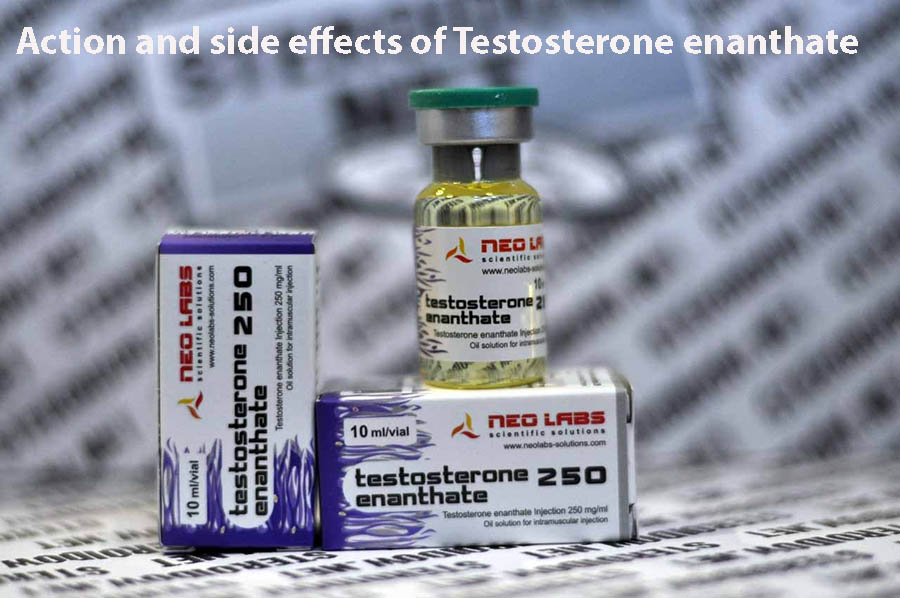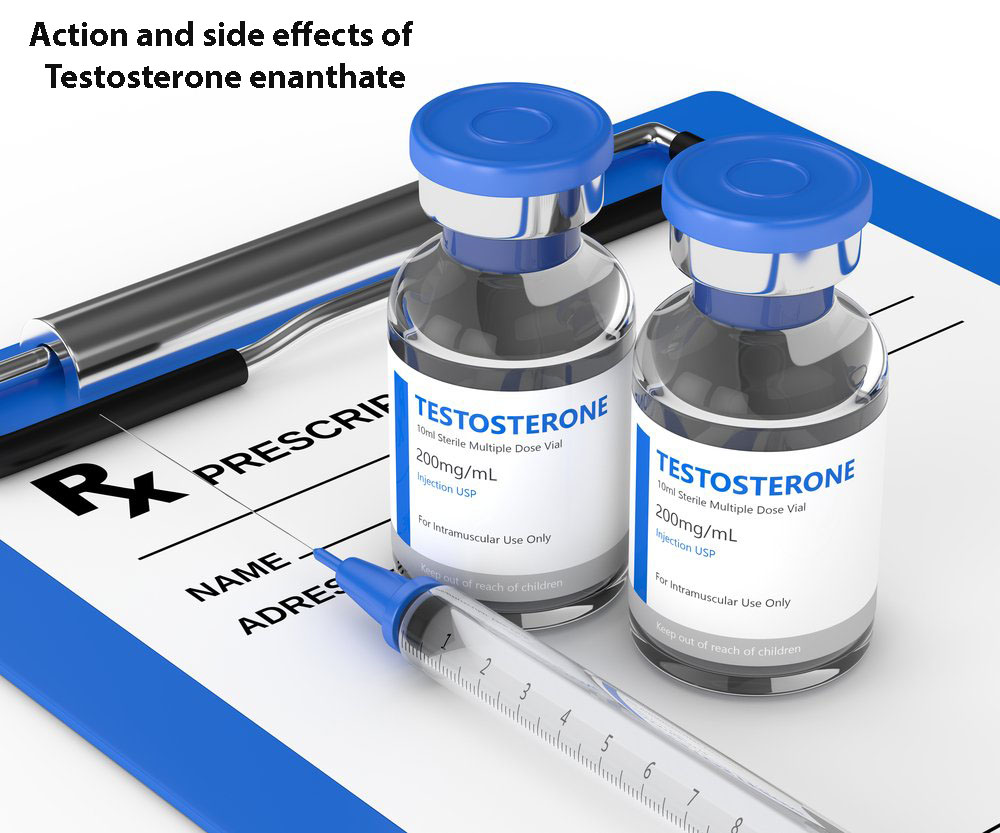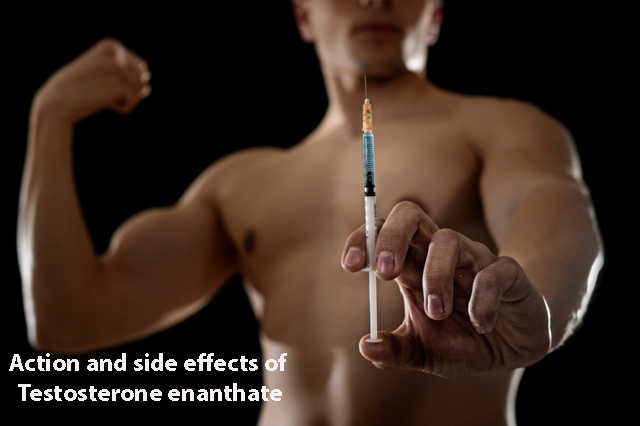Pharmacological action
Pharmacological action – androgenic, anabolic, anti-cancer.
Pharmacology and pharmacodynamics
The main endogenous androgen responsible for the growth and development of the male reproductive organs and the maintenance of secondary sexual characteristics. These effects include the growth and maturation of the prostate, seminal vesicles, penis, and scrotum; Development of a male hair distribution pattern such as B. on the face, pubis, chest and armpits; Swelling of the larynx, thickening of the vocal cords, and changes in muscle and fat distribution.
Androgens also retain nitrogen, sodium, potassium, and phosphorus, and reduce urinary calcium excretion. Androgens increase protein anabolism and reduce protein catabolism. The nitrogen balance only improves with sufficient consumption of calories and protein.
In many tissues, the activity of Testosterone Enanthate depends on reduction to dihydroTestosterone Enanthate, which binds to receptor proteins in the cytosol. The steroid-receptor complex is transported to the nucleus where it initiates transcriptional events and cellular changes related to the action of androgens.

Androgens are responsible for the spurt of growth during adolescence and for the eventual arrest of linear growth caused by an association of epiphysical growth centers. In children, exogenous androgens accelerate linear growth but can cause a disproportionate acceleration of bone maturation. Long-term use may lead to the connection of epiphyseal growth centers and cessation of the growth process. Androgens stimulate the production of red blood cells by increasing the production of the erythropoiesis stimulating factor.
When administering exogenous androgens, endogenous Testosterone Enanthate release is suppressed by LH feedback inhibition. At high doses of exogenous androgens, spermatogenesis can also be suppressed due to FSH feedback inhibition. There is no convincing evidence that androgens are effective in fractures, surgery and functional uterine bleeding.
Due to insufficient Testosterone Enanthate secretion, a clinical syndrome appears – male hypogonadism, which has two main causes. Primary hypogonadism is caused by defects in the gonads such as Klinefelter’s syndrome or Leydig cell aplasia, secondary hypogonadism is the inability of the hypothalamus (or pituitary gland) to produce enough LHRH (or gonadotrophins – FSH or LH).
Pharmacokinetics
Registration and distribution
Testosterone Enanthate esters are less polar than free Testosterone Enanthate. When oily solutions are administered, Testosterone Enanthate esters are reabsorbed by the lipid phase and Testosterone Enanthate is released by side chain cleavage by tissue esterases.
Testosterone Enanthate in the blood plasma binds to specific SHBG (up to 98%), the rest – to albumin or is in the free state.
After transdermal administration, the systemic absorption is 10% of the applied dose.
Time to peak MI is 7 days for Testosterone Enanthate undecanoate (median; range 4 to 42 days), nasal Testosterone Enanthate 40 minutes, transdermal 8 hours (range 4 to 12 hours), oral administration – 2 to 5 hours, and using s / c implant (Testosterone Enanthate enanthate) – 11 hours (median; range 5.8 to 166.7 hours).
The duration of action depends on the route of administration and the type of ester, and ranges from 2 to 4 weeks for intramuscular Testosterone Enanthate and enanthate and 18 weeks for Testosterone Enanthate undecanoate. The duration of the action for external use is 24 hours.
Metabolism
Testosterone Enanthate is metabolized in the liver to the various 17-keto steroids in two different ways. The main active metabolites of Testosterone Enanthate are estradiol and dihydroTestosterone Enanthate.
Racing
Testosterone Enanthate T1 / 2 ranges significantly from 10 to 100 minutes. T1 / 2 Testosterone Enanthate with / m2 administration is about 8 days.
About 90% of an intramuscular dose of Testosterone Enanthate is excreted in the urine as conjugates with glucuronic acid, sulfuric acid and other metabolites. About 6% of the dose is excreted in the faeces, mainly as unconjugated form.

Side effects of Testosterone Enanthate
Adverse effects observed with the use of all dosage forms of Testosterone Enanthate and its esters are listed below, indicating the overall frequency of their development and/or the route of administration.
Very common (> 10%)
- On the CCC side: hypertension (≤13%; intranasal -> 6%).
- On the skin: blistering and itching at the transdermal application site (12%).
- From the urogenital system: increase in prostate specific antigen (≤ 18%; internal – 2%), BPH (12%).
- Hematological and oncological diseases: increase in hematocrit (s / c – from 8 to 14%; external, oral – ≤6%; intramuscular – 1%).
Common (1 to 10%)
From the side of the cardiovascular system: peripheral edema (<1%; s / c – 3%), peripheral vascular disease (transdermal – <3%).
From the side of the central nervous system: emotional lability (in / m, external – ≤3%), change in smell (intranasal – 5 to> 6%; local – 1%), anosmia (intranasal – 6%), pain head (≤5%), procedural pain (MI, intranasal – 4%), depression (≤3%), nervousness (≤3%), thought disorder (transdermal – <3%), anxiety (<3%) , pain (transdermal <3%), chills (transdermal <3%), confusion (transdermal <3%), fatigue (<3%), paresthesia (<3%), dizziness (transdermal <3%), irritability (in / m – 2%), sleep apnea ( 2%), insomnia (in / m, s / c, external – from 1 to 2%), aggressive behavior (in / m – 1%).
Skin side: acne (≤8%), scabs on nasal skin (intranasal – 4-6%), skin irritation (intranasal – ≤6%), contact dermatitis (transdermal – 2-4%), bulla (transdermal – <3%), rash (<3%), pruritus (≤2%), xeroderma (external – ≤2%), erythema (external – ≥1%), hyperhidrosis (im – 1%), alopecia (external – ≤ 1% ).
Endocrine and Metabolic Disorders: HDL cholesterol decreased (external, oral – ≤6%), hyperlipidemia (≤6%), hypokalemia (external – ≤6%), serum triglyceride increased (≤6%), blood glucose increased TSH (intranasal – ≤ 6%), plasma estradiol increased (IM – 3%), libido decreased (≤ 3%), gynecomastia (≤ 3%), hot flushes (IM, external – 1 %), weight gain (in/m – 1%) .
From the gastrointestinal tract: decreased appetite (intranasal – ≤6%), nausea (≤6%; oral, s/c – 2%), diarrhea (≤4%), dysgeusia (<3%), GERD (transdermal – <3%), gastrointestinal bleeding (transdermal – <3%), increased appetite (external, transdermal – <3%), abdominal pain (s/c – 2%).
From the urogenital system: testicular atrophy (intranasal, external – ≤6%), prostate disease (external, transdermal – from 3 to 5%), hypogonadism (im – 3%), mastalgia (external – ≤3%), prostatitis (im, s/c, transdermal – ≤3%), urinary tract infection (s/c, transdermal – ≤3%), dysuria (im, transdermal – <3%), hematuria (s/c, transdermal – < 3%), impotence (transdermal – <3%), pelvic pain (transdermal – <3%), urinary incontinence (transdermal – <3%), testicular disease (including tenderness and non-palpable testicles, external – 2%).
Hematological and oncological diseases: anemia (external – 3%), polycythaemia (≤ 3%), prostate cancer (external, transdermal – < 3%), elevated Hb levels (im, external – ≤ 2%).
On the liver side: serum bilirubin increased (external – ≤ 6%), abnormal liver function tests (1%).
On the renal side: increased serum creatinine (external – ≤ 6%), polyuria (transdermal – < 3%).
From the side of the respiratory system: nasopharyngitis (intranasal – from 4 to 9%; external – ≤1%), rhinorrhea (intranasal – from 4 to 8%), nosebleeds (intranasal – from 4 to 7%), nasal discomfort ( intranasal – 4-6%), bronchitis (intranasal – 4%), upper respiratory tract infections (intranasal – 4%), nasal dryness (intranasal – ≤4%), nasal congestion (intranasal – ≤4%), sinusitis ( i/m, intranasal – ≤4%), cough (i/m, intranasal, s/c – ≤3%).
From the neuromuscular and skeletal system: back pain (s/c, transdermal – 3-6%), myalgia (in/m, intranasal – ≤ 6%), extremity pain (intranasal, external – ≤ 4%), a CPK- Level in blood sample (s/c – 3-4%), asthenia (external – ≤3%), abnormal bone growth (accelerated; transdermal – <3%), hemarthrosis (transdermal – <3%), arthralgia (c /c – 2%).
Local reactions: injection site bruising (s / c – 4-7%), application site erythema (external, transdermal – ≤7%), application site vesicles (transdermal – 6%), application site haemorrhage injection (n / c – 3 – 6%), application site reaction (external – ≤ 6%), injection site pain (im – 5%), application site hardening application (transdermal – 3%) , injection site erythema (s / c – 3%; / m – 1%), application site irritation (transdermal – <3%), application site rash (transdermal – <3%), local peeling of the skin (transdermal, topical – <3%), burning sensation at the application site (transdermal – <3%), transdermal – 1-3%), swelling at the application site (external – ≥ 1%).
Frequency not defined
From the side of the central nervous system: aggression (outward).
Hepatic side: hepatic adenoma (in / m; long-term treatment with Testosterone Enanthate enanthate).
Local reactions: seal at the injection site (u / c).
